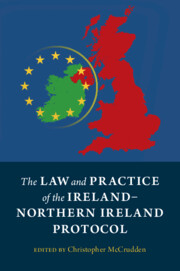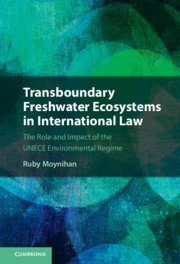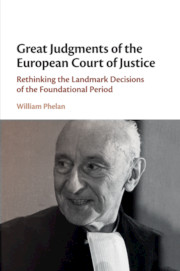46 results
Conclusion
-
-
- Book:
- The Cambridge Handbook of Digital Evidence in Criminal Investigations
- Published online:
- 02 January 2025
- Print publication:
- 09 January 2025, pp 587-592
-
- Chapter
- Export citation
A transnational double movement? Polanyian reflections on conflicts law constitutionalism
-
- Journal:
- European Law Open ,
- Published online by Cambridge University Press:
- 09 January 2025, pp. 1-13
-
- Article
-
- You have access
- Open access
- HTML
- Export citation
Social networks and the impact of the European Court of Human Rights
-
- Journal:
- European Law Open / Volume 3 / Issue 2 / June 2024
- Published online by Cambridge University Press:
- 09 December 2024, pp. 418-430
-
- Article
-
- You have access
- Open access
- HTML
- Export citation
Europe’s unheeded vocation: from reconstructive vision to counterfactual critique
-
- Journal:
- European Law Open ,
- Published online by Cambridge University Press:
- 21 November 2024, pp. 1-17
-
- Article
-
- You have access
- Open access
- HTML
- Export citation
Europe’s legal revolution and France’s Article 49-3: the constitutional audacity of Robert Lecourt
-
- Journal:
- European Law Open / Volume 3 / Issue 2 / June 2024
- Published online by Cambridge University Press:
- 22 October 2024, pp. 226-245
-
- Article
-
- You have access
- Open access
- HTML
- Export citation
‘Economic constitutionalism in a turbulent world’: a critical review
-
- Journal:
- European Law Open / Volume 3 / Issue 2 / June 2024
- Published online by Cambridge University Press:
- 24 September 2024, pp. 456-471
-
- Article
-
- You have access
- Open access
- HTML
- Export citation
EJRR Special Issue: The Future of Food Law after and Beyond the Farm to Fork Strategy
-
- Journal:
- European Journal of Risk Regulation / Volume 15 / Issue 2 / June 2024
- Published online by Cambridge University Press:
- 23 September 2024, pp. 215-221
-
- Article
-
- You have access
- HTML
- Export citation
9 - Government Use of Facial Recognition Technologies under European Law
- from Part II - Facial Recognition Technology across the Globe
-
-
- Book:
- The Cambridge Handbook of Facial Recognition in the Modern State
- Published online:
- 28 March 2024
- Print publication:
- 04 April 2024, pp 127-138
-
- Chapter
-
- You have access
- Open access
- HTML
- Export citation
PRODUCT LIABILITY AND ONLINE MARKETPLACES: COMPARISON AND REFORM
-
- Journal:
- International & Comparative Law Quarterly / Volume 73 / Issue 2 / April 2024
- Published online by Cambridge University Press:
- 30 April 2024, pp. 477-504
- Print publication:
- April 2024
-
- Article
-
- You have access
- Open access
- HTML
- Export citation
European financial law and the state-finance nexus: Sovereign privileges or market discipline for safe public debt?
-
- Journal:
- Finance and Society / Volume 9 / Issue 2 / 2023
- Published online by Cambridge University Press:
- 09 November 2023, pp. 39-57
-
- Article
-
- You have access
- Open access
- Export citation
25 - The ‘Terrible’ Functional Constitution of the European Union
- from Part III - Analyses
-
-
- Book:
- The Cambridge Handbook on the Material Constitution
- Published online:
- 15 January 2023
- Print publication:
- 05 January 2023, pp 351-366
-
- Chapter
- Export citation
Introduction
-
- Book:
- Network Responsibility
- Published online:
- 14 July 2022
- Print publication:
- 28 July 2022, pp 1-28
-
- Chapter
- Export citation
Adjudicating national contexts – Domestic particularity in the practices of the European Court of Human Rights?
-
- Journal:
- German Law Journal / Volume 23 / Issue 4 / May 2022
- Published online by Cambridge University Press:
- 26 May 2022, pp. 465-492
-
- Article
-
- You have access
- Open access
- HTML
- Export citation
Digital constitutionalism across the Atlantic
-
- Journal:
- Global Constitutionalism / Volume 11 / Issue 2 / July 2022
- Published online by Cambridge University Press:
- 11 April 2022, pp. 297-324
-
- Article
- Export citation
ONE STEP FORWARD, TWO STEPS BACK? INTERPRETING ‘PARTICULAR SOCIAL GROUP’ IN THE EUROPEAN UNION
-
- Journal:
- International & Comparative Law Quarterly / Volume 71 / Issue 2 / April 2022
- Published online by Cambridge University Press:
- 22 March 2022, pp. 425-451
- Print publication:
- April 2022
-
- Article
-
- You have access
- Open access
- HTML
- Export citation

The Law and Practice of the Ireland-Northern Ireland Protocol
-
- Published online:
- 20 January 2022
- Print publication:
- 03 February 2022
-
- Book
-
- You have access
- Open access
- Export citation

Transboundary Freshwater Ecosystems in International Law
- The Role and Impact of the UNECE Environmental Regime
-
- Published online:
- 01 October 2021
- Print publication:
- 14 October 2021

Great Judgments of the European Court of Justice
- Rethinking the Landmark Decisions of the Foundational Period
-
- Published online:
- 04 November 2020
- Print publication:
- 13 June 2019
RECONCILING INTERNATIONAL INVESTMENT LAW AND EUROPEAN UNION LAW IN THE WAKE OF ACHMEA
-
- Journal:
- International & Comparative Law Quarterly / Volume 69 / Issue 4 / October 2020
- Published online by Cambridge University Press:
- 18 September 2020, pp. 907-943
- Print publication:
- October 2020
-
- Article
- Export citation
UNDERSTANDING CLAIM PROXIMITY IN THE EU REGIME OF JURISDICTION AGREEMENTS
-
- Journal:
- International & Comparative Law Quarterly / Volume 69 / Issue 2 / April 2020
- Published online by Cambridge University Press:
- 16 April 2020, pp. 431-449
- Print publication:
- April 2020
-
- Article
- Export citation


